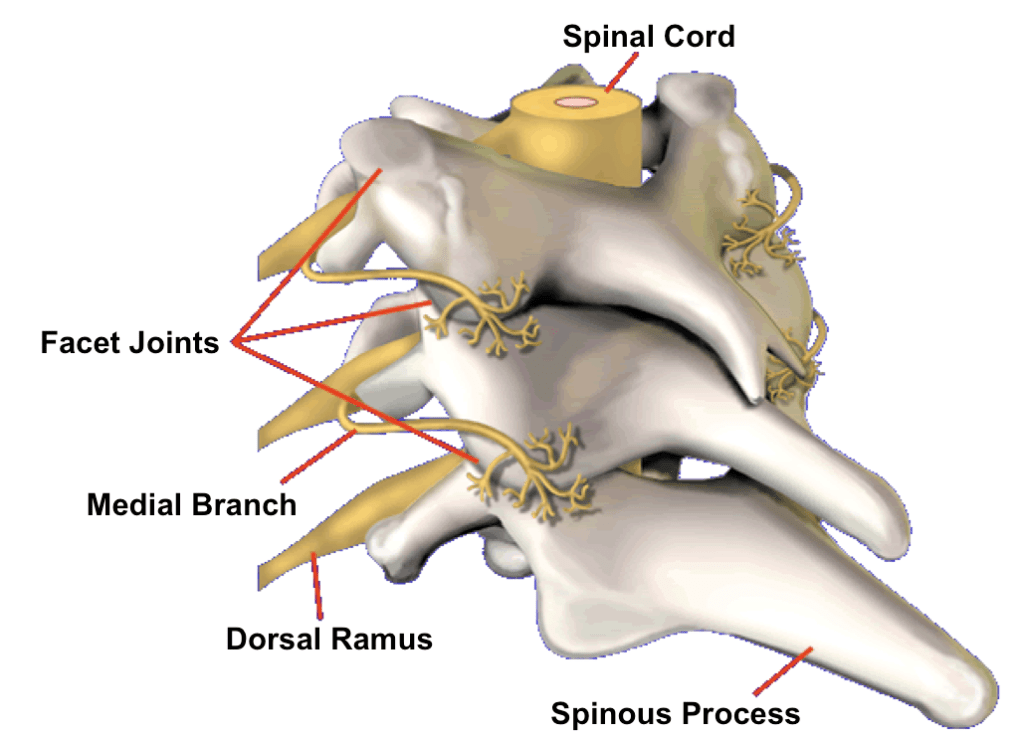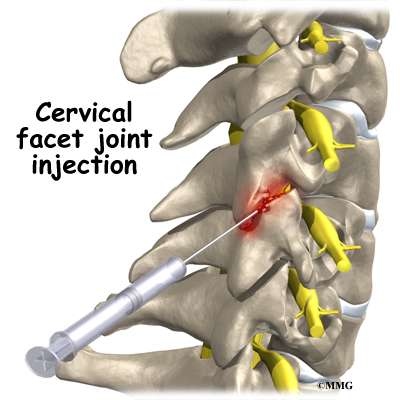Neck – Cervical Medial Branch Blocks
What are Cervical facet joints?
Facet joints (also called zygapophyseal joints) are small joints of the spine that provide stability and help guide motion. They are found in the neck (cervical), upper back (thoracic) and lower back (cervical). They can become painful as a result of arthritis, injury or mechanical stress.Two nerves called “medial branches” supply each facet joint. These nerves carry pain signals to the spinal cord and these signals will eventually reach the brain.The proportion of patients who are affected by facet related pain increased with age and can be as high as 45% in patient population with spinal pain.

What is a Cervical Medial Branch Block procedure?
The facet joints and/or Cervical medial branch nerves can be injected with a local anaesthetic and/or steroid.
There are two reasons for doing this:
- Diagnosis:If the local anaesthetic in the injection relieves your pain then it suggests that the Cervical facet joints are a source of your pain. Repeating the procedure, a second time improves accuracy of the diagnosis. This can guide future treatment such as “radio frequency lesioning” of Cervical medial branch nerves. There is strong scientific evidence to support this.
- Therapy:The steroid in the injection can reduce inflammation, reduce Cervical medial branch nerve sensitivity and provide long lasting pain relief. The duration of pain relief may h blocks are diagnostic injections utilized to assess the contribution of the facet joints to the patient’s spinal pain.

What happens during the procedure?
The procedure is performed in the operation theatre. You will be sedated and local anaesthesia will be used to numb your skin. The doctor will then insert a small needle near the Cervical medial branch nerve. Fluoroscopy, a type of x-ray, will be used to ensure the safe and proper position of the needle. Once the doctor is sure the needle is correctly placed, the medicine is injected.
What happens after the procedure?
You will be monitored for up to monitored closely in the recovery room for 30 minutes after the injection. When you are ready to leave, the staff will give you discharge instructions. You will need to keep a pain diary. It is important to maintain a diary to help the doctor ascertain the success of the diagnostic injection. You may feel immediate pain relief and numbness in your back for a limited period of time after the injection which is the local anaesthetic effect and an indication that the right areas were targeted.
How long can I expect pain relief?
The Cervical medial branch block is a diagnostic procedure like any other medical imaging modality e.g. X-ray, MRI scans. The expectation is that you have short-term good quality pain reduction. If that is the case you maybe a suitable candidate for radiofrequency ablation (RFA) of the cervical medial branch nerve. This procedure provides a more sustained disruption of pain signals and often prolonged pain relief.
How do I prepare for the procedure?
Please advise staff if you are:
- Taking blood thinners (especially warfarin and clopidogrel)
- Diabetic
- Pregnant (or any chance of you being pregnant).
- Allergic to iodine, betadine, shellfish, local anaesthetics, or steroids.
- Unwell (especially if you have an infection)
Staff may advise you to:
- Fast
- Take your usual medications (apart from those mentioned above)
- Arrange for someone to accompany you home
Neck – Cervical Medial Branch Blocks
What are Cervical facet joints?
Facet joints (also called zygapophyseal joints) are small joints of the spine that provide stability and help guide motion. They are found in the neck (cervical), upper back (thoracic) and lower back (cervical). They can become painful as a result of arthritis, injury or mechanical stress.Two nerves called “medial branches” supply each facet joint. These nerves carry pain signals to the spinal cord and these signals will eventually reach the brain.The proportion of patients who are affected by facet related pain increased with age and can be as high as 45% in patient population with spinal pain.


What is a Cervical Medial Branch Block procedure?
The facet joints and/or Cervical medial branch nerves can be injected with a local anaesthetic and/or steroid.
There are two reasons for doing this:
- Diagnosis:If the local anaesthetic in the injection relieves your pain then it suggests that the Cervical facet joints are a source of your pain. Repeating the procedure, a second time improves accuracy of the diagnosis. This can guide future treatment such as “radio frequency lesioning” of Cervical medial branch nerves. There is strong scientific evidence to support this.
- Therapy:The steroid in the injection can reduce inflammation, reduce Cervical medial branch nerve sensitivity and provide long lasting pain relief. The duration of pain relief may h blocks are diagnostic injections utilized to assess the contribution of the facet joints to the patient’s spinal pain.
What happens during the procedure?
The procedure is performed in the operation theatre. You will be sedated and local anaesthesia will be used to numb your skin. The doctor will then insert a small needle near the Cervical medial branch nerve. Fluoroscopy, a type of x-ray, will be used to ensure the safe and proper position of the needle. Once the doctor is sure the needle is correctly placed, the medicine is injected.
What happens after the procedure?
You will be monitored for up to monitored closely in the recovery room for 30 minutes after the injection. When you are ready to leave, the staff will give you discharge instructions. You will need to keep a pain diary. It is important to maintain a diary to help the doctor ascertain the success of the diagnostic injection. You may feel immediate pain relief and numbness in your back for a limited period of time after the injection which is the local anaesthetic effect and an indication that the right areas were targeted.
How long can I expect pain relief?
The Cervical medial branch block is a diagnostic procedure like any other medical imaging modality e.g. X-ray, MRI scans. The expectation is that you have short-term good quality pain reduction. If that is the case you maybe a suitable candidate for radiofrequency ablation (RFA) of the cervical medial branch nerve. This procedure provides a more sustained disruption of pain signals and often prolonged pain relief.
How do I prepare for the procedure?
Please advise staff if you are:
- Taking blood thinners (especially warfarin and clopidogrel)
- Diabetic
- Pregnant (or any chance of you being pregnant).
- Allergic to iodine, betadine, shellfish, local anaesthetics, or steroids.
- Unwell (especially if you have an infection)
Staff may advise you to:
- Fast
- Take your usual medications (apart from those mentioned above)
- Arrange for someone to accompany you home




